TOYOTA PRIUS V 2016 ZVW40 / 1.G Owners Manual
Manufacturer: TOYOTA, Model Year: 2016, Model line: PRIUS V, Model: TOYOTA PRIUS V 2016 ZVW40 / 1.GPages: 620, PDF Size: 29.83 MB
Page 541 of 620

5418-2. Steps to take in an emergency
PRIUS v_OM_OM47B12U_(U)
8
When trouble arises
WARNING
■Avoiding 12-volt battery fires or explosions
Observe the following precautions to prevent accidentally igniting the flam-
mable gas that may be emitted from the 12-volt battery:
●Make sure each jumper cable is connected to the correct terminal and that
it is not unintentionally in contact with any other than the intended terminal.
●Do not allow the other end of the jumper cable connected to the “+” termi-
nal to come into contact with any other parts or metal surfaces in the area,
such as brackets or unpainted metal.
●Do not allow the + and - clamps of the jumper cables to come into contact
with each other.
●Do not smoke, use matches, cigarette lighters or allow open flame near
the 12-volt battery.
■12-volt battery precautions
The 12-volt battery contains poisonous and corrosive acidic electrolyte,
while related parts contain lead and lead compounds. Observe the following
precautions when handling the 12-volt battery:
●When working with the 12-volt battery, always wear safety glasses and
take care not to allow any battery fluids (acid) to come into contact with
skin, clothing or the vehicle body.
●Do not lean over the 12-volt battery.
●In the event that battery fluid comes into contact with the skin or eyes,
immediately wash the affected area with water and seek medical attention.
Place a wet sponge or cloth over the affected area until medical attention
can be received.
●Always wash your hands after handling the 12-volt battery support, termi-
nals, and other battery-related parts.
●Do not allow children near the 12-volt battery.
■After recharging the 12-volt battery
Have the 12-volt battery inspected at your Toyota dealer as soon as possi-
ble.
If the 12-volt battery is deteriorating, continued use may cause the 12-volt
battery to emit a malodorous gas, which may be detrimental to the health of
passengers.
■When replacing the 12-volt battery
P. 441
Page 542 of 620
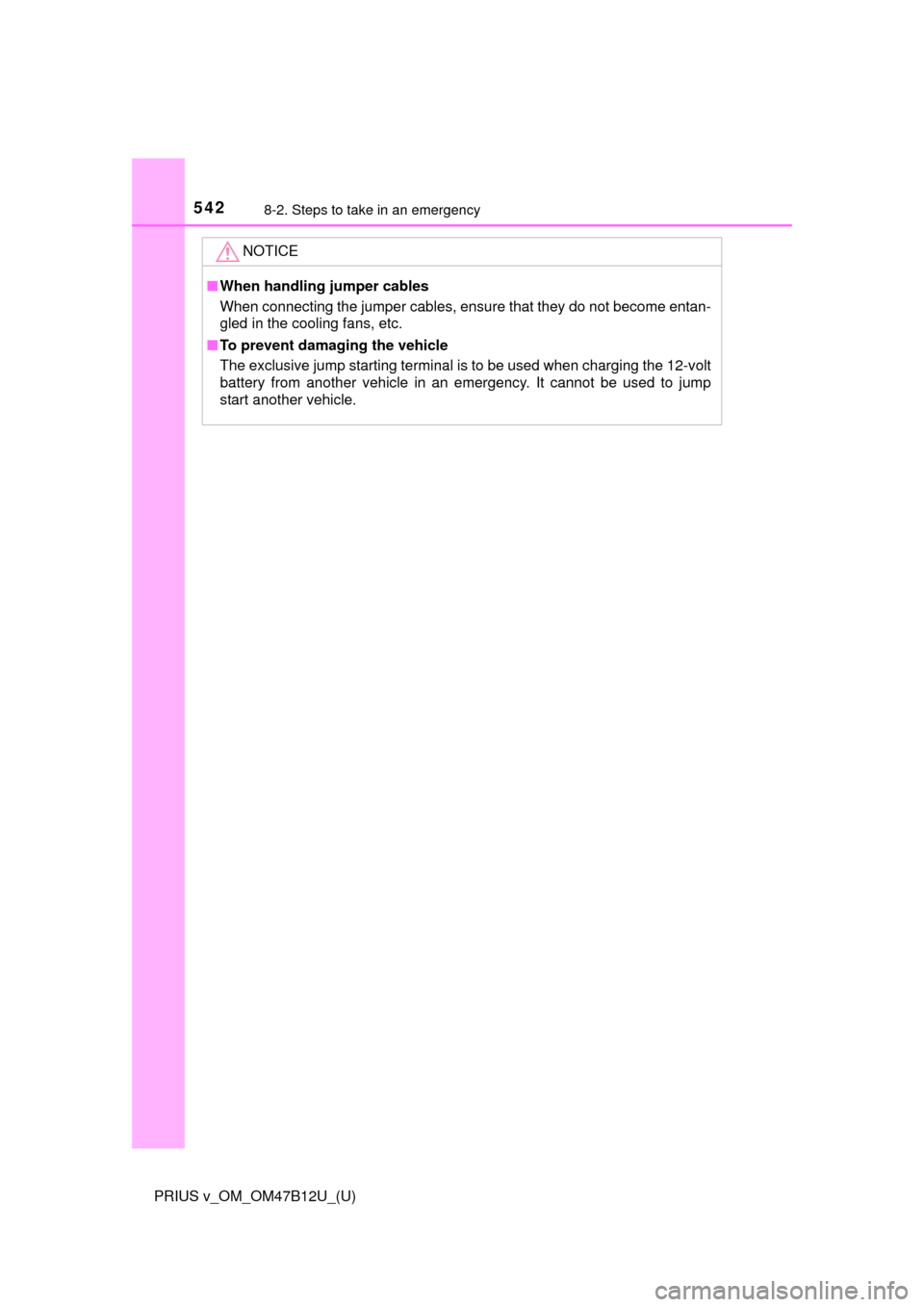
5428-2. Steps to take in an emergency
PRIUS v_OM_OM47B12U_(U)
NOTICE
■When handling jumper cables
When connecting the jumper cables, ensure that they do not become entan-
gled in the cooling fans, etc.
■To prevent damaging the vehicle
The exclusive jump starting terminal is to be used when charging the 12-volt
battery from another vehicle in an emergency. It cannot be used to jump
start another vehicle.
Page 543 of 620
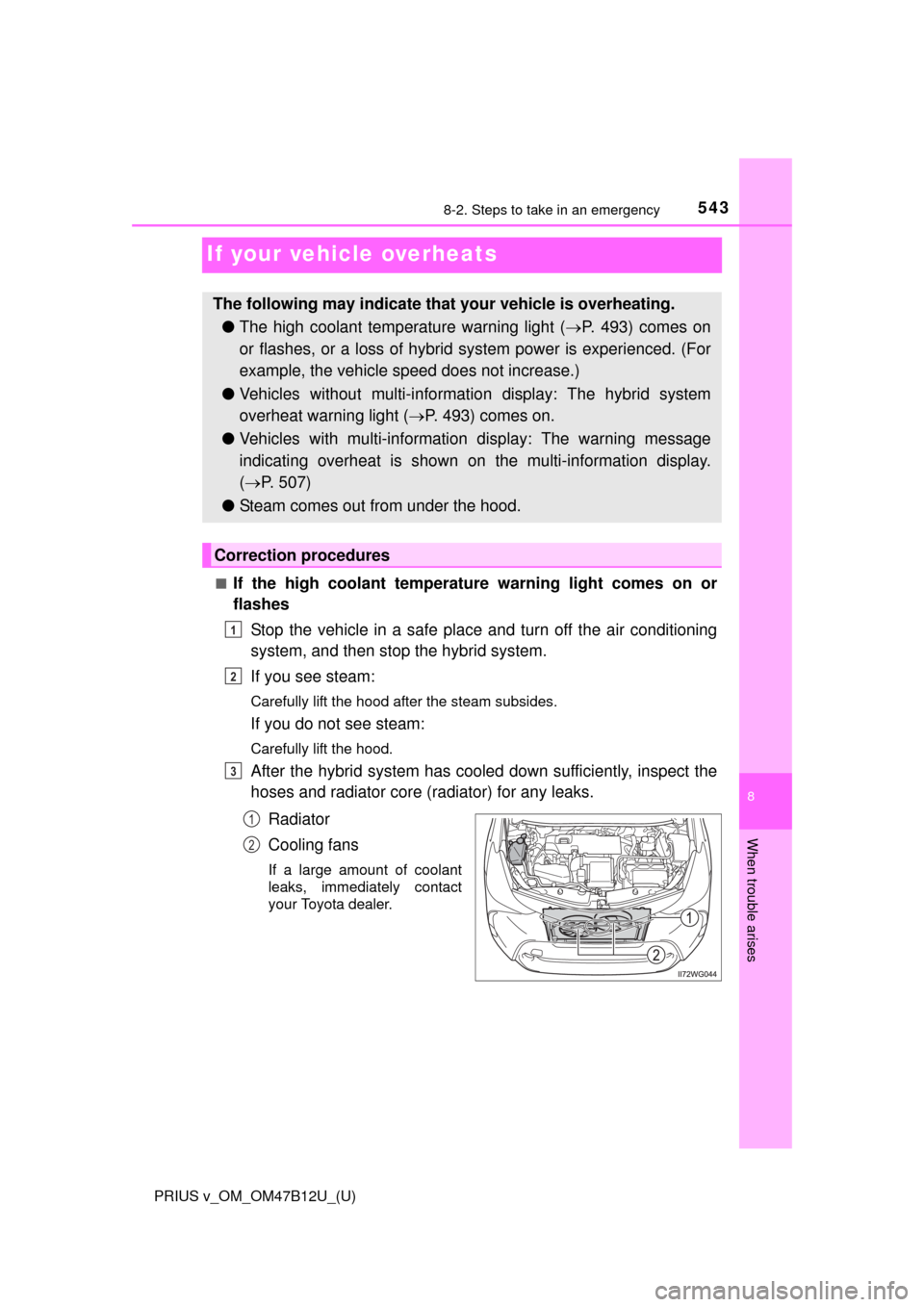
543
PRIUS v_OM_OM47B12U_(U)
8
When trouble arises
8-2. Steps to take in an emergency
If your vehicle overheats
■If the high coolant temperature warning light comes on or
flashes
Stop the vehicle in a safe place and turn off the air conditioning
system, and then stop the hybrid system.
If you see steam:
Carefully lift the hood after the steam subsides.
If you do not see steam:
Carefully lift the hood.
After the hybrid system has cooled down sufficiently, inspect the
hoses and radiator core (radiator) for any leaks.
Radiator
Cooling fans
If a large amount of coolant
leaks, immediately contact
your Toyota dealer.
The following may indicate that your vehicle is overheating.
●The high coolant temperature warning light (P. 493) comes on
or flashes, or a loss of hybrid system power is experienced. (For
example, the vehicle speed does not increase.)
●Vehicles without multi-information display: The hybrid system
overheat warning light (P. 493) comes on.
●Vehicles with multi-information display: The warning message
indicating overheat is shown on the multi-information display.
(P. 507)
●Steam comes out from under the hood.
Correction procedures
1
2
3
1
2
Page 544 of 620
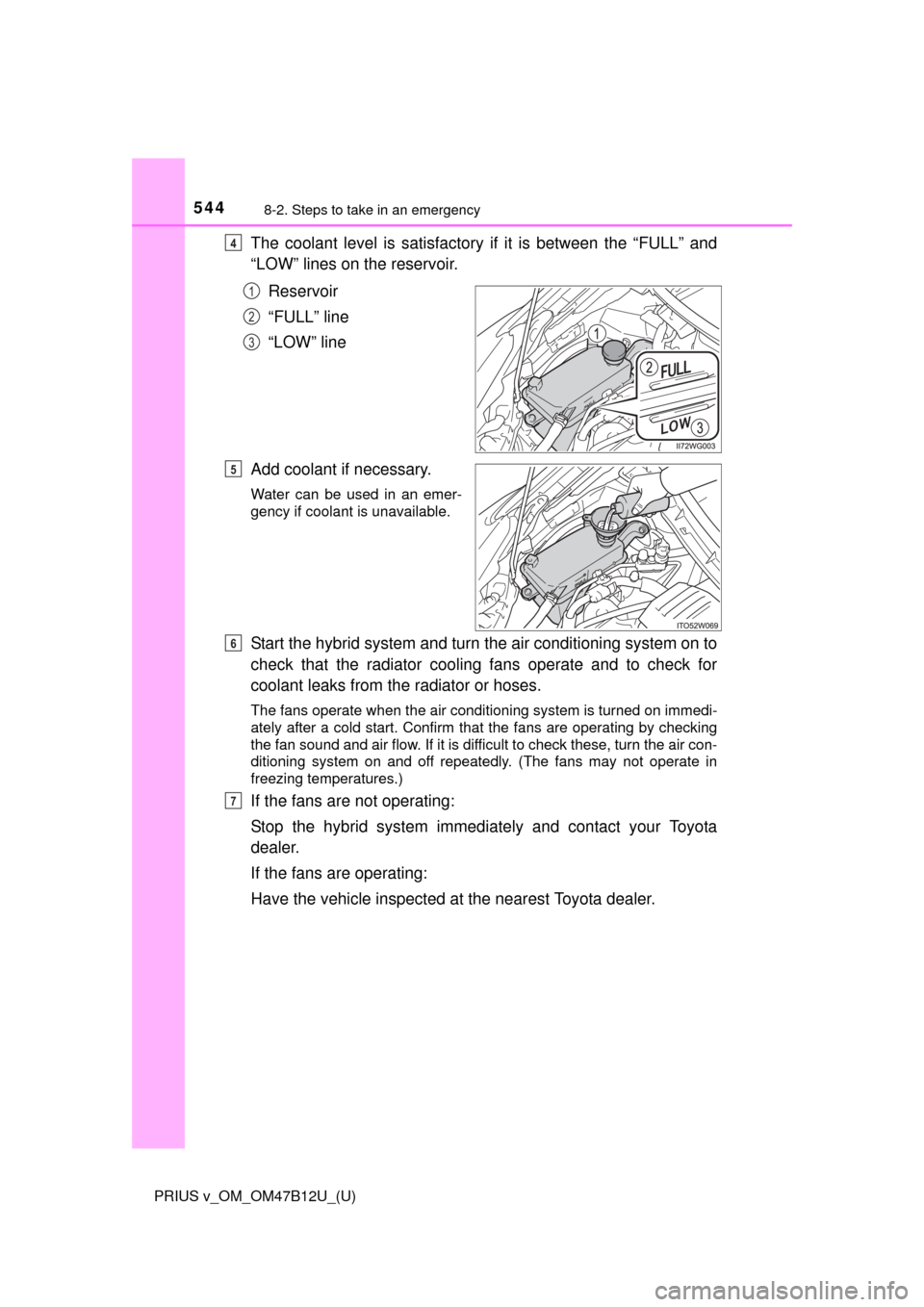
5448-2. Steps to take in an emergency
PRIUS v_OM_OM47B12U_(U)
The coolant level is satisfactory if it is between the “FULL” and
“LOW” lines on the reservoir.
Reservoir
“FULL” line
“LOW” line
Add coolant if necessary.
Water can be used in an emer-
gency if coolant is unavailable.
Start the hybrid system and turn the air conditioning system on to
check that the radiator cooling fans operate and to check for
coolant leaks from the radiator or hoses.
The fans operate when the air conditioning system is turned on immedi-
ately after a cold start. Confirm that the fans are operating by checking
the fan sound and air flow. If it is difficult to check these, turn the air con-
ditioning system on and off repeatedly. (The fans may not operate in
freezing temperatures.)
If the fans are not operating:
Stop the hybrid system immediately and contact your Toyota
dealer.
If the fans are operating:
Have the vehicle inspected at the nearest Toyota dealer.
4
1
2
3
5
6
7
Page 545 of 620
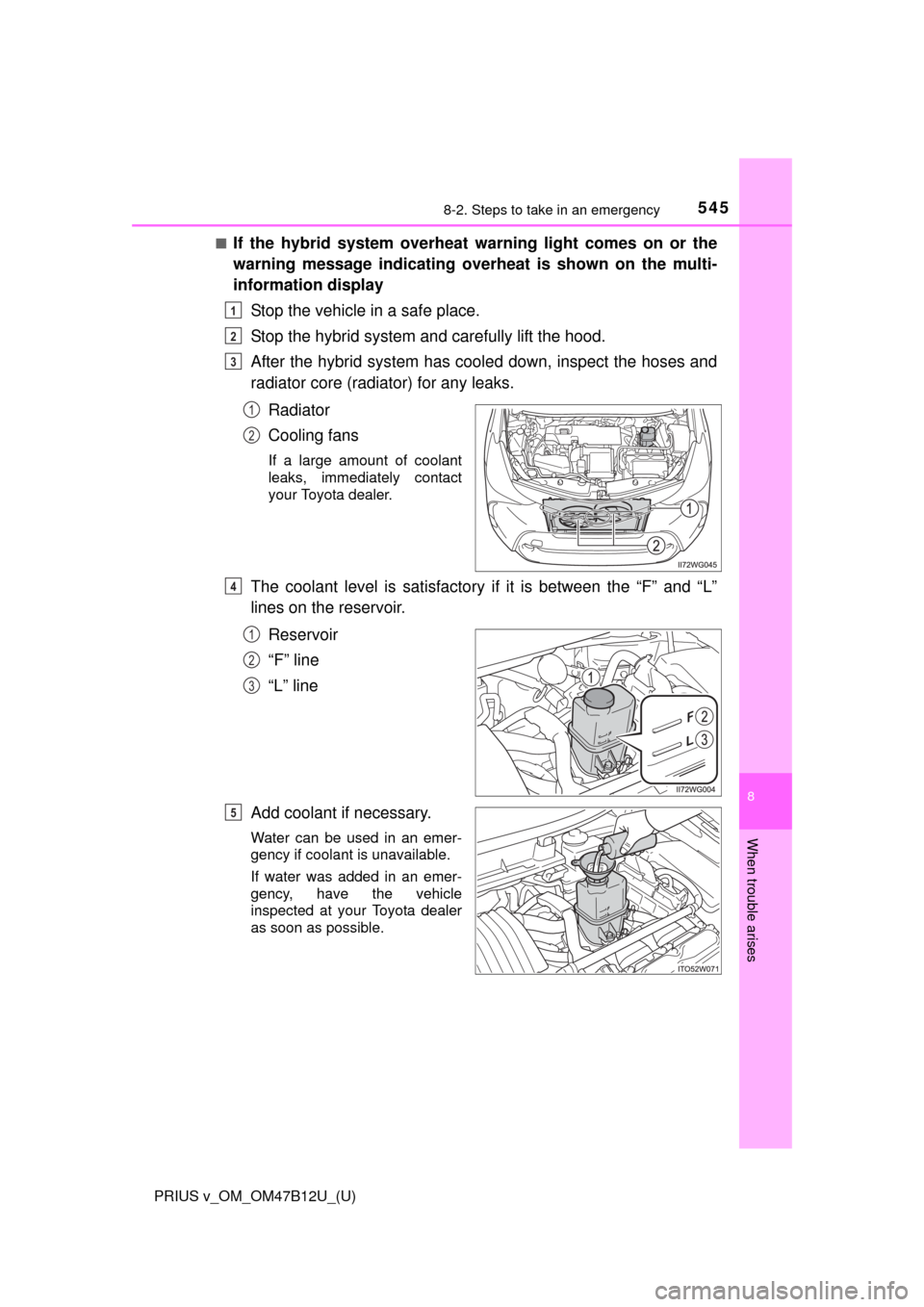
5458-2. Steps to take in an emergency
PRIUS v_OM_OM47B12U_(U)
8
When trouble arises
■If the hybrid system overheat warning light comes on or the
warning message indicating overheat is shown on the multi-
information display
Stop the vehicle in a safe place.
Stop the hybrid system and carefully lift the hood.
After the hybrid system has cooled down, inspect the hoses and
radiator core (radiator) for any leaks.
Radiator
Cooling fans
If a large amount of coolant
leaks, immediately contact
your Toyota dealer.
The coolant level is satisfactory if it is between the “F” and “L”
lines on the reservoir.
Reservoir
“F” line
“L” line
Add coolant if necessary.
Water can be used in an emer-
gency if coolant is unavailable.
If water was added in an emer-
gency, have the vehicle
inspected at your Toyota dealer
as soon as possible.
1
2
3
1
2
4
1
2
3
5
Page 546 of 620

5468-2. Steps to take in an emergency
PRIUS v_OM_OM47B12U_(U)
After stopping the hybrid system and waiting for 5 minutes or
more, start the hybrid system and check for the instrument clus-
ter or multi-information display.
If the hybrid system overheat warning light does not turn off or
the message does not disappear:
Stop the hybrid system and contact your Toyota dealer.
If the hybrid system overheat warning light does not come on or
the message is not displayed:
The hybrid system temperature has dropped and the vehicle may
be driven normally.
However, if the warning light comes on again frequently or the message
appears again frequently, contact your Toyota dealer.
WARNING
■When inspecting under the hood of your vehicle
Observe the following precautions.
Failure to do so may result in serious injury such as burns.
●If steam is seen coming from under the hood, do not open the hood until
the steam has subsided. The engine compartment may be very hot.
●After the hybrid system has been turned off, check that the indicator on the
power switch and the “READY” indicator are off.
When the hybrid system is operating, the gasoline engine may automati-
cally start, or the cooling fan may suddenly operate even if the gasoline
engine stops. Do not touch or approach rotating parts such as the fan,
which may lead to fingers or clothing (especially a tie, a scarf or a muffler)
getting caught, resulting in serious injury.
●Do not loosen the coolant reservoir cap while the hybrid system and radia-
tor are hot.
High temperature steam or coolant could spray out.
6
Page 547 of 620
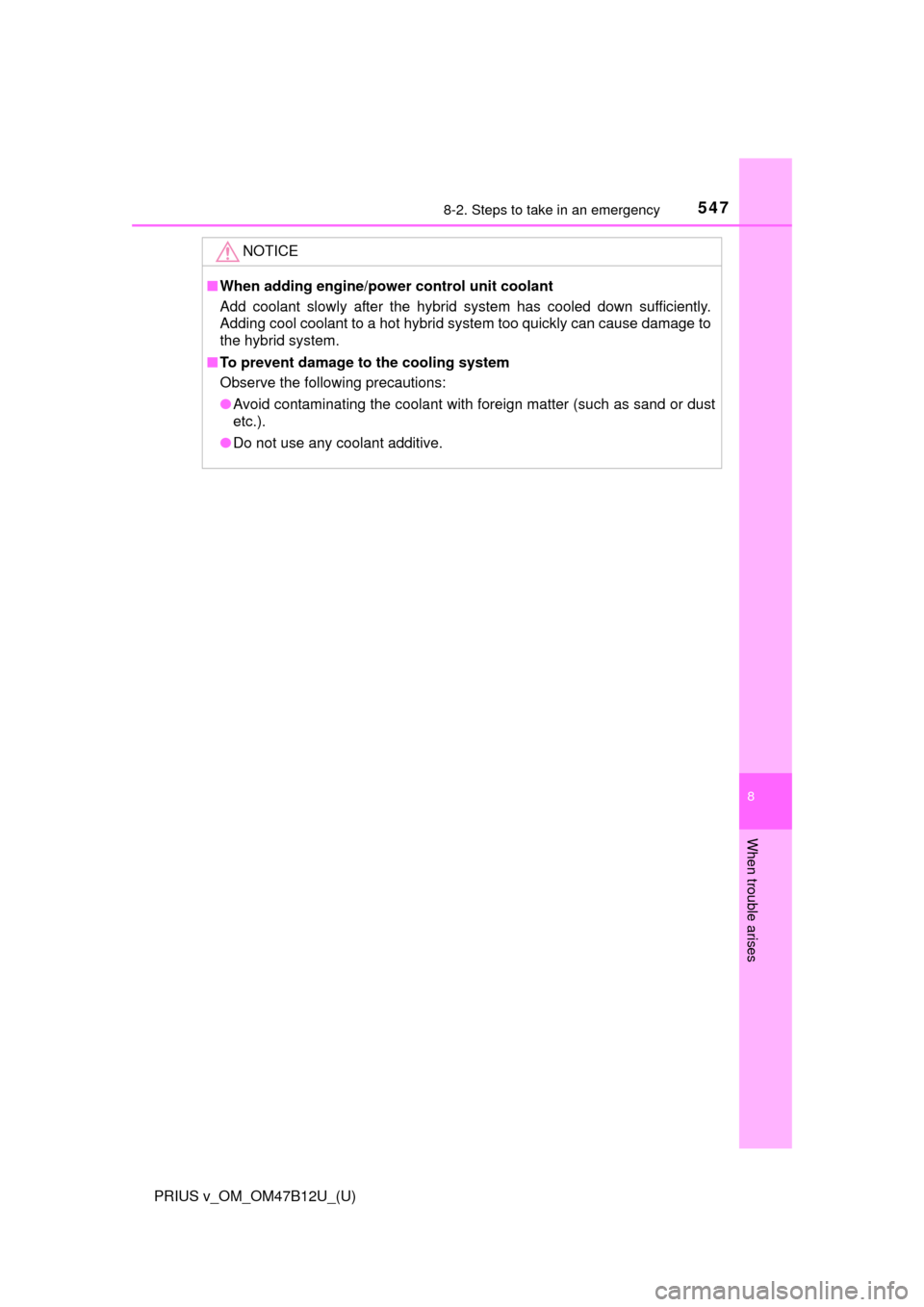
5478-2. Steps to take in an emergency
PRIUS v_OM_OM47B12U_(U)
8
When trouble arises
NOTICE
■When adding engine/power control unit coolant
Add coolant slowly after the hybrid system has cooled down sufficiently.
Adding cool coolant to a hot hybrid system too quickly can cause damage to
the hybrid system.
■To prevent damage to the cooling system
Observe the following precautions:
●Avoid contaminating the coolant with foreign matter (such as sand or dust
etc.).
●Do not use any coolant additive.
Page 548 of 620
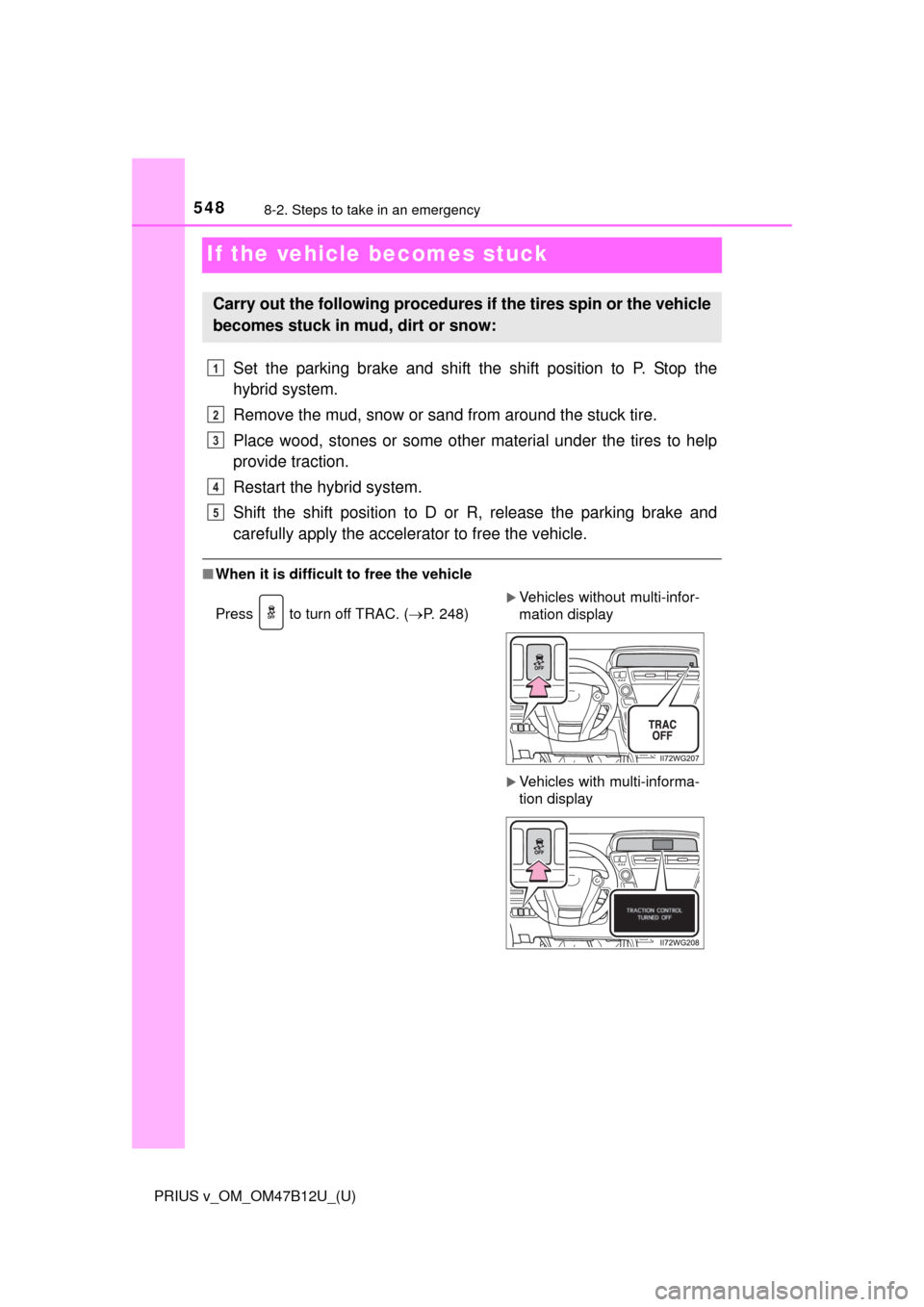
548
PRIUS v_OM_OM47B12U_(U)
8-2. Steps to take in an emergency
If the vehicle becomes stuck
Set the parking brake and shift the shift position to P. Stop the
hybrid system.
Remove the mud, snow or sand from around the stuck tire.
Place wood, stones or some other material under the tires to help
provide traction.
Restart the hybrid system.
Shift the shift position to D or R, release the parking brake and
carefully apply the accelerator to free the vehicle.
■When it is difficult to free the vehicle
Carry out the following procedures if the tires spin or the vehicle
becomes stuck in mud, dirt or snow:
Press to turn off TRAC. (P. 248)
Vehicles without multi-infor-
mation display
Vehicles with multi-informa-
tion display
1
2
3
4
5
Page 549 of 620
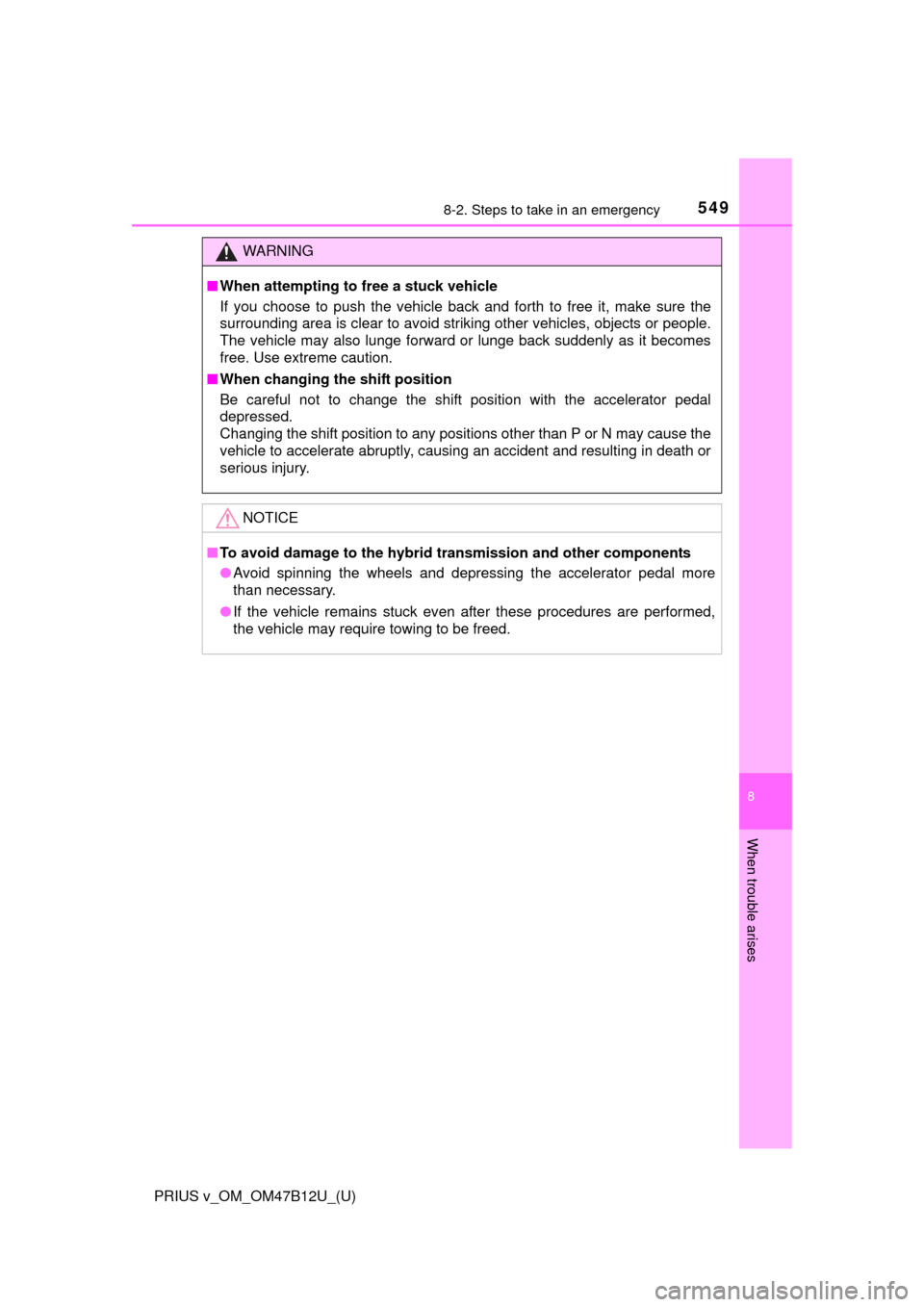
5498-2. Steps to take in an emergency
PRIUS v_OM_OM47B12U_(U)
8
When trouble arises
WARNING
■When attempting to free a stuck vehicle
If you choose to push the vehicle back and forth to free it, make sure the
surrounding area is clear to avoid striking other vehicles, objects or people.
The vehicle may also lunge forward or lunge back suddenly as it becomes
free. Use extreme caution.
■When changing the shift position
Be careful not to change the shift position with the accelerator pedal
depressed.
Changing the shift position to any positions other than P or N may cause the
vehicle to accelerate abruptly, causing an accident and resulting in death or
serious injury.
NOTICE
■To avoid damage to the hybrid transmission and other components
●Avoid spinning the wheels and depressing the accelerator pedal more
than necessary.
●If the vehicle remains stuck even after these procedures are performed,
the vehicle may require towing to be freed.
Page 550 of 620

5508-2. Steps to take in an emergency
PRIUS v_OM_OM47B12U_(U)